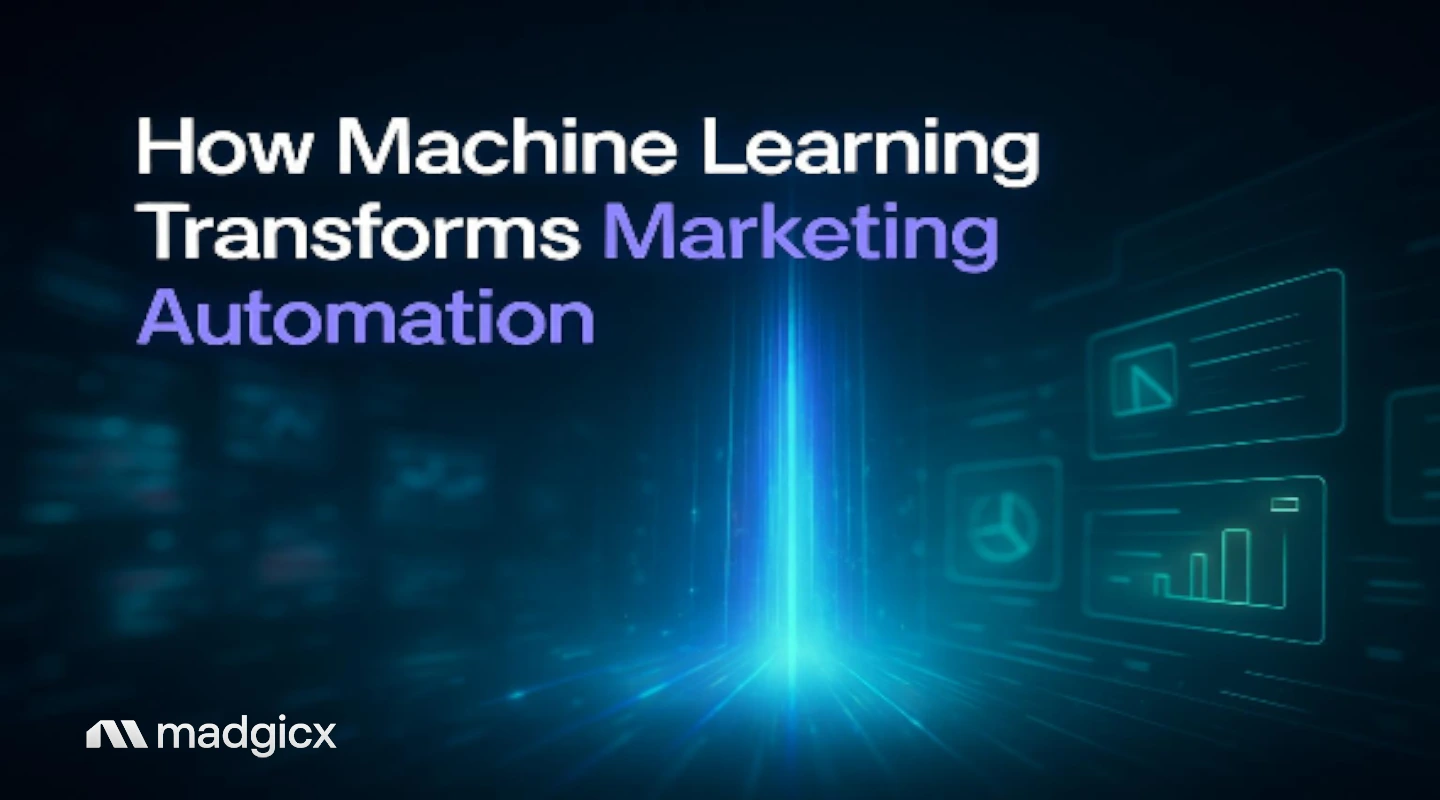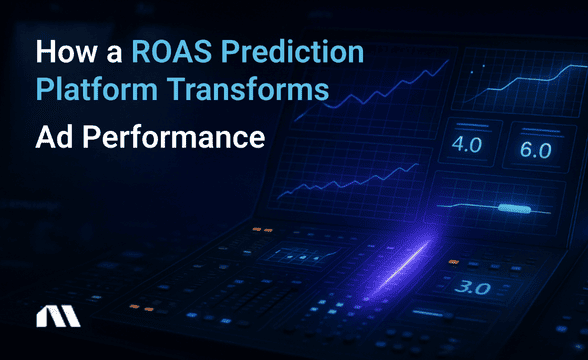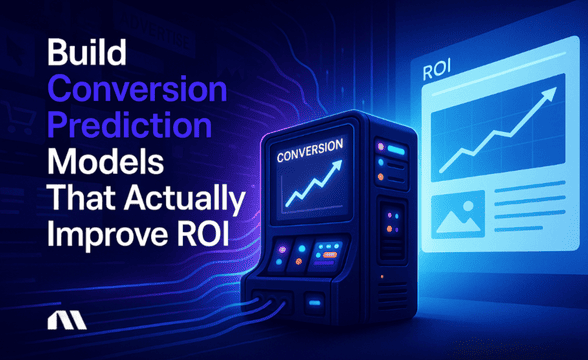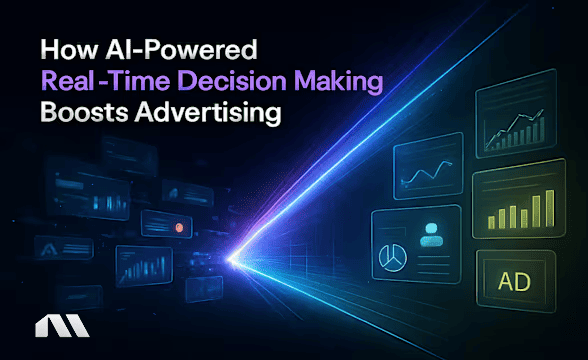Discover how machine learning transforms marketing automation with ROAS improvements. Full guide with real performance benchmarks and optimization strategies.
You know that feeling when you're juggling 15 different ad campaigns across Facebook, Google, and TikTok? Every morning starts the same way - coffee in hand, diving into performance dashboards, adjusting budgets, pausing the duds, and scaling the winners. By lunch, you've made 47 manual tweaks. By 5 PM, you're questioning your life choices.
Here's the thing: there's a smarter way to do this, and it doesn't involve hiring three more team members or surviving on energy drinks.
Machine learning in marketing automation isn't just about reclaiming your evenings (though you absolutely will). It's about making optimization decisions faster and with greater data processing capability than manual methods, using data patterns that would take us weeks to spot manually.
The numbers tell the story: 92% of marketers say automation is key to remaining competitive, and the marketing automation market is projected to reach $15.58 billion by 2030. But here's what most guides won't tell you - the difference between basic automation and machine learning automation is like comparing a pocket calculator to Deep Blue.
What You'll Learn in This Guide
Ready to level up your automation game? This comprehensive guide covers everything you need to transform your advertising operations:
- How machine learning differs from traditional automation (and why it matters for your bottom line)
- 5 specific ML applications delivering measurable ROI improvements with real metrics
- Step-by-step implementation framework for integrating ML into your current workflow
- Performance benchmarks and optimization strategies from top-performing campaigns
Let's dive in.
Machine Learning vs Traditional Marketing Automation: The Performance Gap
Traditional marketing automation is like having a really obedient intern. You set up if-then rules, and it follows them religiously. Machine learning automation? That's like having a chess grandmaster who gets smarter every game.
How Traditional Automation Works:
- IF cost per click > $2.00
- THEN reduce budget by 20%
- IF conversion rate drops below 2%
- THEN pause ad set
Simple, predictable, and limited.
Machine Learning Takes a Different Approach:
- Analyzes 847+ data points including time of day, audience behavior, creative performance, weather patterns, and competitor activity
- Predicts optimal budget allocation across 12 ad sets simultaneously
- Adjusts bids in real-time based on conversion probability models
- Learns from every interaction to improve future decisions
The performance impact? Some companies using AI-driven marketing automation report ROI improvements of up to 544% compared to traditional methods. That's not a typo - we're talking about more than 5x return on investment.
Think about it this way: traditional automation follows your rules. Machine learning automation writes better rules than you could, then continuously improves them based on data you'd never have time to analyze manually.
Pro Tip: The sweet spot for ML automation is campaigns with at least $5,000 monthly spend. Below this threshold, there isn't enough data for the algorithms to identify meaningful patterns and make consistently good decisions.
5 Machine Learning Applications That Drive Measurable Results
Let's get specific. Here are five ML applications that performance marketers are using right now to crush their KPIs:
Application #1: Predictive Budget Allocation
Instead of spreading your budget evenly or making gut-based decisions, ML algorithms analyze historical performance data to predict which campaigns will perform best at different times. They automatically allocate budget accordingly.
How it works: The algorithm considers factors like historical performance, seasonal trends, audience behavior patterns, and competitive landscape to predict where your next dollar will generate the highest return.
Performance Impact: 25-40% improvement in ROAS through optimal budget distribution. One e-commerce client saw their ROAS jump from 3.2x to 4.7x within six weeks of implementing predictive budget allocation.
Application #2: Creative Performance Optimization
AI advertising tools analyze visual elements, copy variations, and audience responses to predict creative performance before launch and optimize during campaigns. Reduces guesswork in creative testing.
How it works: Creative intelligence AI examines thousands of successful ads to identify patterns in colors, text placement, emotional triggers, and visual composition that drive conversions for your specific audience.
Performance Impact: 30-50% reduction in creative testing time with 20% higher engagement rates. Plus, you'll reduce budget waste on creatives with lower performance potential.
Application #3: Advanced Audience Lookalike Modeling
Forget basic demographic lookalikes. ML creates sophisticated audience models by analyzing behavioral patterns, purchase intent signals, and engagement data that goes way beyond "women aged 25-34 who like yoga."
How it works: The algorithm identifies micro-patterns in your best customers' behavior - things like time spent on specific product pages, scroll patterns, and interaction sequences - then finds prospects with similar digital fingerprints.
Performance Impact: 15-25% lower cost per acquisition with higher lifetime value customers. Your lookalike audiences actually look like your best customers, not just their surface-level demographics.
Application #4: Real-Time Bid Optimization
ML continuously adjusts bids based on real-time data, including conversion probability, competition levels, user behavior signals, and dozens of other factors that change by the minute.
How it works: Machine learning algorithms process real-time auction data, user intent signals, and historical conversion patterns to determine the optimal bid for each impression opportunity.
Performance Impact: 20-35% improvement in conversion rates with reduced cost per conversion. The algorithm bids aggressively when it spots high-intent users and pulls back when conversion probability drops.
Application #5: Cross-Platform Campaign Orchestration
AI coordinates campaigns across multiple platforms, optimizing message sequencing and budget allocation for maximum impact across the entire customer journey.
How it works: The system tracks users across touchpoints, understanding which platforms work best for awareness, consideration, and conversion phases. It then orchestrates campaigns to guide prospects through the optimal path to purchase.
Performance Impact: 40-60% improvement in multi-touch attribution and customer journey optimization. Instead of competing against yourself across platforms, your campaigns work together like a well-oiled machine.
Pro Tip: Start with single-platform ML automation before attempting cross-platform orchestration. Master Facebook automation, then expand to Google, then TikTok. Trying to do everything at once is a recipe for confusion and suboptimal results.
Implementation Framework: From Setup to Optimization
Ready to implement ML automation? Here's your step-by-step roadmap:
Phase 1: Data Foundation (Week 1-2)
Before any ML magic can happen, you need clean, comprehensive data. This phase is like preparing the soil before planting - boring but essential.
Week 1 Tasks:
- Audit current data quality across all platforms
- Identify and fix tracking gaps (missing pixels, broken UTM parameters, etc.)
- Implement proper attribution models for multi-touch campaigns
- Document current performance baselines
Week 2 Tasks:
- Set up conversion prediction models for key metrics
- Ensure data consistency across platforms
- Establish data governance protocols
- Create performance benchmark reports
Pro Tip: Don't skip this phase. ML algorithms are only as good as the data they're trained on. Garbage in, garbage out.
Phase 2: Platform Selection and Setup (Week 3-4)
Choose your ML-powered automation platform based on your specific needs and integrate it with your existing martech stack.
Week 3: Platform Evaluation
- Assess integration capabilities with your current tools
- Evaluate ML sophistication and customization options
- Review performance tracking and attribution features
- Calculate potential ROI based on your current metrics
Week 4: Implementation
- Configure initial campaign parameters and learning objectives
- Set up automated reporting and alert systems
- Establish safety nets (spending limits, performance thresholds)
- Train your team on the new platform
For Facebook and Instagram advertising, Madgicx's AI advertising platform offers deep integration with Meta's ecosystem, making this phase significantly smoother.
Phase 3: Gradual Rollout (Week 5-8)
Start small, learn fast, scale smart. Don't hand over your entire budget to automated systems on day one.
Week 5-6: Initial Testing
- Start with 20-30% of budget on automated campaigns
- Run parallel manual campaigns for comparison
- Monitor performance against established baselines
- Document learnings and optimization opportunities
Week 7-8: Refinement
- Adjust ML parameters based on initial results
- Expand to additional campaign types or audiences
- Fine-tune automation rules and safety parameters
- Prepare for broader rollout
Success Metric: 44% of companies see ROI within the first six months of implementation. Many users begin seeing positive trends by week 6-8.
Phase 4: Scale and Optimize (Week 9+)
Time to unleash the full power of ML automation across your campaigns.
Scaling Strategy:
- Gradually increase automated budget allocation to 70-80%
- Implement advanced ML features like cross-platform optimization
- Set up real-time decision-making protocols
- Continuously refine based on performance data
Ongoing Optimization:
- Monthly performance reviews and strategy adjustments
- Quarterly ML model retraining with fresh data
- Regular competitive analysis and feature updates
- Team training on new ML capabilities
Platform Comparison: Choosing the Right ML Solution
Not all ML automation platforms are created equal. Here's how to choose the right one for your needs:
Enterprise Solutions
Salesforce Marketing Cloud
- Best for: Complex B2B funnels with long sales cycles
- Strengths: Deep CRM integration, advanced lead scoring
- Considerations: Steep learning curve, higher investment required
Adobe Experience Platform
- Best for: Content-heavy campaigns with personalization needs
- Strengths: Creative optimization, cross-channel orchestration
- Considerations: Requires significant technical resources
HubSpot
- Best for: Inbound marketing automation and lead nurturing
- Strengths: User-friendly interface, comprehensive feature set
- Considerations: Limited advanced ML capabilities
Performance-Focused Solutions
- Best for: Facebook/Instagram advertising optimization
- Strengths: AI-first approach, deep Meta integration, performance focus
- Specialization: Primarily a Meta-focused advertising platform
Optmyzr
- Best for: Google Ads optimization specialists
- Strengths: Advanced PPC automation, detailed reporting
- Specialization: Google ecosystem focus
Acquisio
- Best for: Multi-platform PPC automation
- Strengths: Cross-platform capabilities, agency-friendly
- Considerations: Different ML approach than specialized platforms
Selection Criteria Checklist
When evaluating platforms, consider:
✅ Integration Capabilities: Does it play nice with your existing martech stack?
✅ ML Sophistication: How advanced are the algorithms and learning capabilities?
✅ Performance Tracking: Can you measure ROI and attribute results accurately?
✅ Cost Structure: Does the pricing model align with your budget and expected ROI?
✅ Support and Training: What resources are available for implementation and optimization?
Measuring Success: KPIs and Optimization Strategies
You can't optimize what you don't measure. Here's how to track ML automation performance:
Primary Performance Metrics
ROAS Improvement Percentage
- Baseline: Your current ROAS across all campaigns
- Target: 25-40% improvement within 3 months
- Measurement: Compare automated vs. manual campaign performance
Time Saved on Manual Optimizations
- Baseline: Hours spent weekly on manual campaign management
- Target: 60-80% reduction in manual optimization time
- Measurement: Track time allocation before and after implementation
Cost Per Acquisition Reduction
- Baseline: Current CPA across key conversion events
- Target: 15-30% CPA reduction while maintaining quality
- Measurement: Monitor CPA trends and customer lifetime value
Campaign Setup and Testing Speed
- Baseline: Time required to launch and optimize new campaigns
- Target: 50-70% faster campaign deployment
- Measurement: Track time from brief to live campaign
Advanced Optimization Techniques
A/B Testing ML vs. Manual Management
Run controlled experiments comparing ML-optimized campaigns against your best manual optimization strategies. This gives you concrete data on ML performance and helps identify areas for improvement.
Cohort Analysis for Long-Term Performance
Track customer cohorts acquired through ML-optimized campaigns to understand long-term value and retention patterns. Sometimes ML finds customers that convert at lower cost but have higher lifetime value.
Attribution Modeling for Multi-Touch Campaigns
Implement advanced attribution models to understand how ML automation affects the entire customer journey, not just last-click conversions.
Predictive Lifetime Value Optimization
Use ML to optimize for predicted customer lifetime value rather than just immediate conversions. This often leads to higher-quality customers and better long-term ROI.
Pro Tip: Set up weekly automated reports that compare ML performance against your historical manual optimization benchmarks. This helps you spot trends early and make data-driven decisions about scaling automation.
Common Challenges and Solutions
Let's address the elephants in the room - the challenges you'll likely face and how to overcome them:
Challenge #1: Data Quality Issues
The Problem: ML algorithms need clean, comprehensive data to make good decisions. If your tracking is broken or incomplete, the automation will amplify those problems.
The Solution:
- Implement data validation protocols before launching ML automation
- Start with a gradual rollout to identify and fix data problems
- Use server-side tracking solutions to improve data accuracy
- Regular data audits and cleaning processes
Challenge #2: Integration Complexity
The Problem: Your martech stack wasn't designed with ML automation in mind. Getting everything to talk to each other can be challenging.
The Solution:
- Start with single-platform automation before expanding to cross-platform orchestration
- Choose platforms with robust API capabilities and pre-built integrations
- Work with technical partners who understand both marketing and data architecture
- Plan for integration costs and timeline in your implementation budget
Challenge #3: Team Adoption Resistance
The Problem: Your team is worried that ML automation will replace them or make their skills obsolete.
The Solution:
- Begin with augmentation rather than replacement - show ML as a tool that enhances human decision-making
- Provide comprehensive training on new platforms and capabilities
- Clearly communicate how automation frees up time for strategic work
- Celebrate wins and share success stories from early adopters
Challenge #4: Over-Reliance on Automation
The Problem: ML automation is powerful, but it's not infallible. Blindly trusting algorithms without human oversight can lead to problems.
The Solution:
- Maintain human oversight and approval workflows for major decisions
- Set up alerts and safeguards for unusual performance patterns
- Regular strategy reviews to ensure ML optimization aligns with business goals
- Keep manual optimization skills sharp for when you need to intervene
Future of ML in Marketing Automation
The ML automation landscape is evolving rapidly. Here's what's coming in 2025 and beyond:
Privacy-First ML Models
With third-party cookies disappearing and privacy regulations tightening, ML models are adapting to work with first-party data and privacy-safe signals. This means better performance with less invasive tracking.
Real-Time Creative Generation
AI technology is advancing toward real-time creative optimization capabilities based on audience behavior and performance data. This could enable campaigns that automatically create new ad variations when performance starts to decline.
Cross-Device Journey Optimization
Advanced attribution and ML will enable seamless optimization across devices and platforms, understanding the complete customer journey from first touch to conversion and beyond.
Predictive Customer Lifetime Value Modeling
ML will continue improving at predicting not just who will convert, but who will become your most valuable long-term customers. This shifts optimization from immediate conversions to long-term value.
The marketers who embrace these trends early will have a significant competitive advantage. The question isn't whether ML will transform marketing automation - it's whether you'll be leading the charge or playing catch-up.
Frequently Asked Questions
How long does it take to see results from ML marketing automation?
Most performance marketers see initial improvements within 2-4 weeks of proper implementation. Significant results - we're talking 20%+ ROAS improvement - typically show up within 6-8 weeks. The key is having enough data for the algorithms to learn from, which usually requires at least $5,000 monthly ad spend.
What's the minimum budget needed for effective ML automation?
While ML can technically work with smaller budgets, optimal results require $5,000+ monthly ad spend to generate sufficient data for meaningful pattern recognition. Below this threshold, you might see some benefits, but the algorithms won't have enough data to make consistently good decisions.
How do I maintain control while using ML automation?
Modern ML platforms offer granular control settings that let you set boundaries, approval workflows, and override capabilities. You can specify spending limits, performance thresholds, and blacklist certain audiences or placements. Think of it as setting guardrails rather than giving up control entirely.
Can ML automation work with my existing martech stack?
Most enterprise ML platforms offer robust API integrations with popular tools like Google Analytics, Salesforce, HubSpot, and Shopify. The key is choosing a solution that connects with your current CRM, analytics, and attribution tools. Always verify integration capabilities before committing to a platform.
What happens if the ML algorithm makes poor decisions?
Quality ML platforms include multiple safeguards: spending limits, performance thresholds, human override capabilities, and automatic pause triggers. Additionally, algorithms continuously learn from mistakes to improve future decisions. The key is setting up proper monitoring and alert systems so you can intervene when needed.
How do I know if ML automation is actually working?
Track specific KPIs like ROAS improvement, time saved on manual optimizations, and cost per acquisition changes. Run A/B tests comparing automated campaigns against your best manual optimization strategies. Most importantly, measure long-term customer value, not just immediate conversions.
Start Your ML Automation Journey Today
The data doesn't lie: machine learning in marketing automation can deliver marketing automation ROI of $5.44 per $1 spent. Companies implementing ML automation often see 25-40% ROAS improvements, save 10+ hours weekly on manual optimizations, and achieve faster, more accurate campaign optimization.
But here's the thing - reading about ML automation won't improve your campaigns. Implementation will.
Your next step? Start with a single campaign or platform to test ML automation's impact on your performance metrics. Whether you choose Madgicx for Facebook/Instagram optimization, or another platform for your specific needs, the key is beginning the transition from manual to machine-powered advertising.
The marketers winning in 2025 won't be those with the biggest budgets - they'll be those who leverage machine learning for Facebook ads and other platforms to make smarter, faster optimization decisions.
Your ML automation journey starts with your next campaign. The question is: will you lead the charge or watch from the sidelines?
Reduce time spent on manual optimizations with machine learning that handles routine tasks in seconds. Madgicx's AI Marketer continuously analyzes your Meta ad campaigns, automatically adjusts budgets, and optimizes for maximum ROAS around the clock. Performance marketers using our platform often see improvements of up to 35% within the first month.
Digital copywriter with a passion for sculpting words that resonate in a digital age.







.avif)







